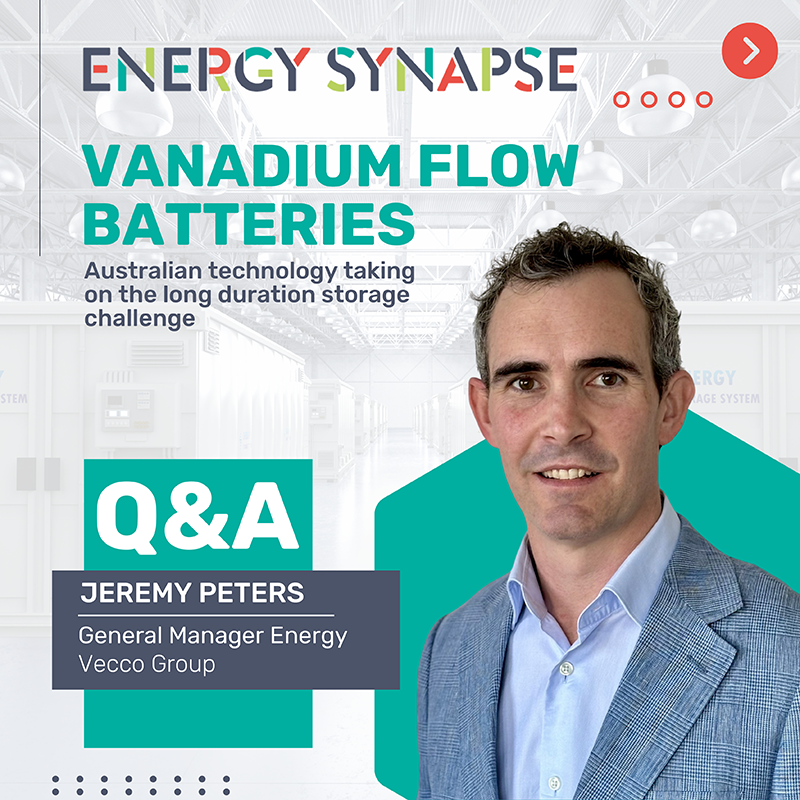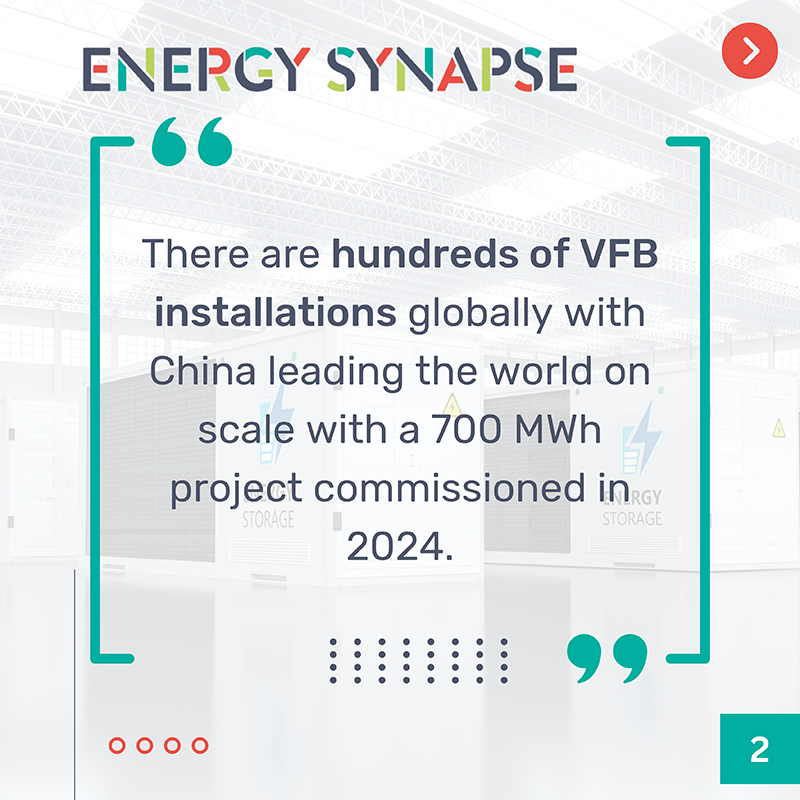Vanadium flow batteries are taking on the long duration storage challenge
February 20, 2025

As Australia continues its transition from fossil fuels to renewable energy, there is growing interest in vanadium flow batteries and other storage technologies that can provide medium-to-long duration storage.
Energy Synapse sat down with Jeremy Peters, an expert in vanadium flow batteries, to get his insights on the key advantages of the technology, how it is being deployed, and where the biggest opportunities are in the Australian market. Jeremy Peters is the General Manager Energy at Vecco Group and is responsible for downstream business including electrolyte manufacturing and battery projects. Jeremy has 20 years of experience in the electrical industry and is a Director of the Advanced Materials and Battery Council
Can you tell us more about vanadium flow battery technology and how it has been deployed internationally?
Vanadium flow batteries (VFBs) are a mature and proven technology developed in Australia in the 1980s and have been commercialised overseas. There are hundreds of VFB installations globally with China leading the world on scale with a 700 MWh project commissioned in 2024 and gigawatt manufacturing facilities now in operation. We are seeing significant growth in the pipeline for VFBs locally in Australia, with recent deployments in South Australia and Western Australia, as well as the battery jointly delivered by Vecco and Sumitomo Electric for Energy Queensland in 2024 with 100% of its electrolyte made at Vecco’s Townsville facility.
VFBs are durable, have no cycle limitation, are not susceptible to thermal runaway and the electrolyte does not degrade. The battery’s energy capacity is directly linked to electrolyte volume installed, with systems typically ranging from 4 to 12 hours of duration. As a result, they are highly scalable and cost-effective. To increase storage, you simply add more electrolyte to the tanks. As capacity (i.e. duration) increases, the cost per kilowatt-hour drops significantly.
Due to their proven capability and unique characteristics, both fundamental to the bankability of these batteries, VFBs are becoming a key long duration energy storage solution set to significantly increase their market share, as the supply chain matures, and adoption accelerates.

What are the biggest opportunities for vanadium flow batteries in an Australian context, in terms of application, size, storage duration?
In Australia, the greatest opportunities for VFBs are in applications requiring long duration storage – typically 6 hours or more – where their unique advantages offer both technical and economic benefits. VFBs excel in scenarios where durability, safety and daily cycling are critical, offering a distinct competitive advantage over other technologies.
The greatest opportunities we see are:
Energy shifting in distribution networks: With Australia having one of the highest per capita rates of rooftop solar, VFBs can play a key role in energy shifting. This means storing excess solar energy generated during the day for use in the evening when demand peaks. Their long-duration capabilities allow for substantial load shifting, easing pressure on the grid and enhancing system resilience.
Diesel replacement in mining and industrial sectors: Australia’s remote mining operations and industrial sites, often relying heavily on diesel generators, can significantly benefit from VFBs. The battery’s ability to provide reliable, long duration storage without degradation makes them an ideal solution for off-grid power, reducing both fuel costs and carbon emissions. VFBs’ durability and unlimited cycle operations also mean they can handle the demanding, continuous energy needs of these industries.
Storage integration with grid scale generation: VFBs can be deployed alongside large-scale generators to improve resilience and allow for more flexibility in export scheduling. Their ability to provide extended discharge times without degradation makes them ideal for balancing out load changes, and smoothing out variability in renewable generation, ensuring a steady supply of power in more situations.
Vecco Group is actively building a local vanadium battery supply chain in Australia. Can you tell us more about the benefits of having a local supply chain and how it will impact VFB economics?
With Australia hosting the world’s third-largest vanadium deposit and established mining and processing capabilities, Vecco plans to leverage our local manufacturing talent and develop a local end-to-end supply chain, rather than relying on the mine-and-export model Australia has adopted in the past.
From our customers, we know that one of the key barriers to vanadium flow battery deployment has been the historical volatility in vanadium prices, which can account for around 60% of the total battery cost. By controlling the entire supply chain – from mining to electrolyte manufacturing – Vecco can offer customers price certainty on the cost of vanadium electrolyte as they develop their battery project.
Our customers also recognise Australia’s low sovereign risk and strong mining reputation, which positions us as a reliable trading partner for VFB projects.
What is needed to increase adoption of VFBs in Australia?
Essentially, everybody needs to keep doing what they’re doing. We are confident the market is heading in the right direction, and it’s important the industry continues advancing technology, improving efficiencies, and reducing costs. Project owners need to critically assess and choose the right battery technology for their specific needs, ensuring that VFBs are considered for suitable applications. Governments also play a crucial role by supporting the development of a secure, domestic supply chain, fostering Australian manufacturing, and reducing reliance on imported batteries.
Are there any unique considerations that project developers and EPCs need to take into account if they are thinking about using vanadium flow batteries in their projects?
The batteries want to be used, developers and owners should focus on maximising the unique advantages these batteries offer. Rather than protecting them from use, they should leverage the unlimited cycle capability, fast response times, and apply value to the elimination of thermal run-away risk. The long battery life (25 years) should be fully utilised and consider a second use or end-of-life cost recovery for the completely reusable electrolyte, adding further value to the system. Too often, we mistakenly see the operational parameters adopted in a lithium-ion battery model lifted and applied to vanadium flow batteries, which leaves value on the table.
We know from our customers that when operated in these sweet spots (e.g. duration, cycling frequency, life of asset etc), VFBs become economically competitive with lithium-ion batteries, which benefit from a mature supply chain operating at significant scale and capital invested.
While VFB technology is mature and proven, its supply chain is only now gaining significant momentum with the recent acceleration of demand for long duration energy storage. China is leading the way with GWh production facilities and battery deployments, which is already bringing costs down through scale and performance improvements. This ongoing investment into the VFB supply chain and learnings from deployments will only improve the cost competitiveness across broader long-duration energy storage applications. In August 2024, the US Department of Energy (DoE) released its extensive Earthshots Report on Long-Duration Energy Storage Technologies, which recognises this pathway for VFBs. The DoE project a levelised cost of storage of $0.06/kWh for flow batteries by 2030, outperforming all other electrochemical and thermal storage systems.
About Vecco Group
Vecco is an integrated critical mineral mining and manufacturing business, developing a vanadium battery supply chain in Australia, the USA & Europe. Vanadium electrolyte is currently being manufactured by Vecco in Townsville at its commercial demonstration scale facility. Vecco’s critical mineral mining project in Julia Creek QLD is under assessment for mining lease approval. Once operational, the Vecco integrated supply chain will mine, process and manufacture over 1 GWh of vanadium electrolyte each year. Vecco is supported by Idemitsu (a global energy company), who recently acquired a controlling interest in Vecco via Idemitsu Australia, taking Idemitsu’s total investment in the Vecco Group to more than AUD $75 million.
About Energy Synapse
Energy Synapse is an Australian modelling and analytics firm specialising in wholesale electricity markets, renewable energy, and energy storage. We can tailor our market and revenue models to account for the unique technical parameters of any storage technology, including vanadium flow batteries. Learn more about our modelling services.

